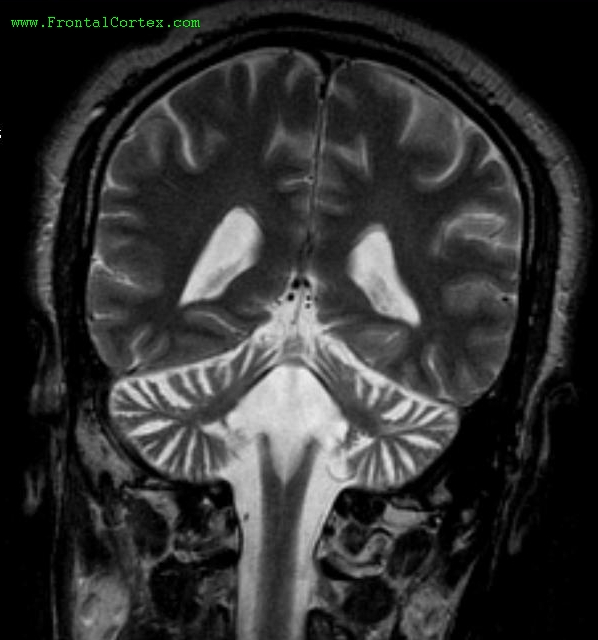Ataxia 01
Topic: Pediatric
Created on Sunday, February 25 2007 by
Last modified on Sunday, February 25 2007.

A 33 year-old female of Portuguese ancestry presents with a 5 year history of progressive dysphagia, ophthalmoplegia, gait difficulties, spasticity, dysarthria, and ataxia.
Her father and paternal grandmother had similar symptoms, as does her sister.
Imaging reveals the findings shown above.
Which of the following statements about this patient's disease is TRUE?
This question was created on February 25, 2007 by .
This question was last modified on February 25, 2007.
ANSWERS AND EXPLANATIONS
A) This disorder is a associated with a CGG trinucleotide repeat expansion.
This answer is incorrect.
This patient's history and imaging are consistent with an autosomal dominant spinocerebellar ataxia, specifically Machado-Joseph disease (SCA3). This is associated with a CAG trinucleotide repeat expansion. A CGG repeat is associated with fragile X syndrome. (
See References)
|
 |  |  | 
|  |  |
| Please log in if you want to rate questions. |
B) This disorder is a associated with a CAG trinucleotide repeat expansion.
This answer is correct.
This patient's history and imaging are consistent with an autosomal dominant spinocerebellar ataxia (SCA). The most common form of this syndrome is Machado-Joseph disease (SCA3), which has a higher incidence in people of Portuguese descent. SCA1, SCA2, SCA3, SCA6, and SCA7 are all associated with CAG trinucleotide repeat expansions. (
See References)
|
 |  |  | 
|  |  |
| Please log in if you want to rate questions. |
C) This disorder is a associated with a CTG trinucleotide repeat expansion.
This answer is incorrect.
This patient's history and imaging are consistent with an autosomal dominant spinocerebellar ataxia, specifically Machado-Joseph disease (SCA3). This is associated with a CAG trinucleotide repeat expansion. A CTG repeat is associated with myotonic dystrophy. (
See References)
|
 |  |  | 
|  |  |
| Please log in if you want to rate questions. |
D) This disorder is a associated with a GAA trinucleotide repeat expansion.
This answer is incorrect.
This patient's history and imaging are consistent with an autosomal dominant spinocerebellar ataxia, specifically Machado-Joseph disease (SCA3). This is associated with a CAG trinucleotide repeat expansion. A GAA repeat is associated with Friedriech ataxia. (
See References)
|
 |  |  | 
|  |  |
| Please log in if you want to rate questions. |
E) This disorder is a associated with a GAC trinucleotide repeat expansion.
This answer is incorrect.
This patient's history and imaging are consistent with an autosomal dominant spinocerebellar ataxia, specifically Machado-Joseph disease (SCA3). This is associated with a CAG trinucleotide repeat expansion. A neurologic disease associated with a GAC trinucleotide repeat expansion has not been described. (
See References)
|
 |  |  | 
|  |  |
| Please log in if you want to rate questions. |
References:
| 1. Victor, M., and Ropper, A.H. (2001). Adams and Victor's Principles of Neurology, 7th Edition. McGraw-Hill, New York. | |
| 2. Bradley, W.G., Daroff, R.B., Fenichel, G.M., and Jankovic, J. (Eds.) (2004). Neurology in Clinical Practice, 4th Edition. Butterworth Heinemann, Philadelphia. | |
| 3. Fenichel, G.M. (2005). Clinical Pediatric Neurology, 5th ed. Elsevier, Philadelphia. | |
|
 |  |  | 
|  |  |
| Please log in if you want to rate questions. |
FrontalCortex.com -- Neurology Review Questions -- Neurology Boards -- Board Review -- Residency Inservice Training Exam -- RITE Exam Review
pediatric
Ataxia 01
Question ID: 022507106
Question written by . (C) FrontalCortex.com 2006-2009, all rights reserved.
Created: 02/25/2007
Modified: 02/25/2007
Estimated Permutations: 0
























